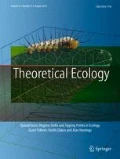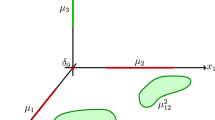Abstract
Stochastic ecological dynamics result from both transient and asymptotic features of the underlying system, yet explanations for observed patterns often emphasize asymptotics. For example, an ecological state (e.g., a particular population size or community composition) that occurs frequently and/or persists for a meaningful duration might be assumed to be a stable equilibrium, even though transients can also persist for a long time and may recur. In this paper, we consider one particular pattern—a bimodal distribution of states as a system is observed through time—and consider alternative causes for this pattern. First, we consider the “asymptotic” explanation that each mode corresponds to a distinct stable state. Second, we consider that one mode might correspond to a long transient. We explore the dynamics that result from each of these causes in a classic bistable model, focusing particularly on the degree of environmental stochasticity needed to generate a bimodal distribution of states in each case. Our results highlight that observations of a system’s dynamics do not provide enough information to determine the number and location of stable states. We conclude that a more serious and systematic consideration for the possible role of transients in driving observed dynamics will lead to stronger insights and understanding.





Similar content being viewed by others
References
Abbott K C, Nolting B C (2017) Alternative (un)stable states in a stochastic predator-prey model. Ecol Complex 32B:181–195
Abis B, Brovkin V (2019) Alternative tree-cover states of the boreal ecosystem: a conceptual model. Global Ecol Biogeogr 5:612–627
Benincà E, Dakos V, Van Nes E, Huisman J, Scheffer M (2011) Resonance of plankton communities with temperature fluctuations. Am Nat 4:E85–95
Berdugo M, Kéfi S, Soliveres S, Maestre F T (2017) Plant spatial patterns identify alternative ecosystem multifunctionality states in global drylands. Nat Ecol Evol 1:0003
Bhatia H, Norgard G, Pascucci V, Bremer P (2012) The Helmholtz-Hodge Decomposition–A survey. IEEE Trans Vis Comp Graphics 19:1386–1404
Blarer A, Doebeli M (1999) Resonance effects and outbreaks in ecological time series. Ecol Lett 2:167–177
Boettiger C (2018) From noise to knowledge: how randomness generates novel phenomena and reveals information. Ecol Lett 21:1255–1267
Bouchet F, Reygner J (2015) Generalisation of the Eyring–Kramers transition rate formula to irreversible diffusion processes. Ann Henri Poincaré 17:3499–3532
Cale W B, Nenbry G M, Yeakley J A (1989) Inferring process from pattern in natural communities. Bioscience 39:600–605
Chesson P A (1985) Coexistence of competitors in spatially and temporally varying environments. Theor Pop Biol 3:263–287
Ellner S P, Turchin P (2005) When can noise induce chaos and why does it matter: a critique. Oikos 3:620–631
Francis T, Abbott KC, Cuddington K, Gellner G, Hastings AM, Lai Y-C, Morozov A, Petrovskii S, Zeeman ML (in review) Management implications of long transients in ecological systems. Nat Ecol Evol
Freidlin M I, Wentzell A D (2012) Random perturbations of dynamical systems, 3rd edn. Springer, Berlin
Hastings A (2001) Transient dynamics and persistence of ecological systems. Ecol Lett 4:215–220
Hastings A (2004) Transients: the key to long-term ecologial understanding? Trends Ecol Evol 19:39–45
Hastings AM, Abbott KC, Cuddington K, Francis T, Gellner G, Lai Y-C, Morozov A, Petrovskii S, Scranton K, Zeeman ML (2018) Transient phenomena in ecology. Science 361:eaat6412
Hirota M, Holmgren M, Van Nes E H, Scheffer M (2011) Global resilience of tropical forest and savanna to critical transitions. Science 334:232–235
Moore CM, Stieha CR, Nolting BC, Cameron MK, Abbott KC (2015) QPot: An R package for calculating quasi-potentials. https://cran.r-project.org/web/packages/QPot/index.html
Moore C M, Stieha C R, Nolting B C, Cameron M K, Abbott K C (2016) QPOt: An R package for stochastic differential equation quasi-potential analysis. R J 8:19–38
Morozov A, Abbott K C, Cuddington K, Francis T, Gellner G, Hastings A M, Lai Y -C, Petrovskii S, Scranton K, Zeeman M L (2020) Long transients in ecology: theory and applications. Phys Life Rev 32:1–40
Nolting B C, Abbott K C (2016) Balls, cups, and quasi-potentials: quantifying stability in stochastic systems. Ecol 97:850–864
R Core Development Team (2017) R: A Language and Environment for Statistical Computing. R Foundation for Statistical Computing. https://www.R-project.org
Rand D, Wilson H (1991) Chaotic stochasticity: a ubiquitous source of unpredictability in epidemics. Proc Roy Soc B 246:179–184
Ripa J, Lundberg P (1996) Noise colour and the risk of population extinctions. Proc Roy Soc B 1377:1751–1753
Scheffer M, Carpenter S R (2003) Catastrophic regime shifts in ecosystems: linking theory to observation. Trends Ecol Evol 18:648–656
Scheffer M, Hirota M, Holmgren M, Van Nes E H, Chapin F S (2012) Thresholds for boreal biome transitions. Proc Nat Acad Sci USA 109:21384–21389
Scheffer M, Carpenter S R, Dakos V, Van Nes E H (2015) Generic indicators of ecological resilience: inferring the chance of a critical transition. Ann Rev Ecol Evol Syst 46:145–167
Shoemaker LG, Sullivan LL, Donohue I, Cabral J, Williams RJ, Mayfield M, Chase J, Chu C, Harpole WS, Huth A, HilleRisLambers J, James ARM, Kraft NJB, May F, Muthukrishnan R, Satterlee S, Taubert F, Wang X, Wiegand T, Yang Q, Abbott KC (2020) Integrating the underlying structure of stochasticity into community ecology. Ecology 101:e02922
Staver A C, Archibald S, Levin S A (2011) The global extent and determinants of savanna and forest as alternative biome states. Science 334:230–232
Strang A (2020) Applications of the Helmholtz-Hodge decomposition to networks and random processes. Dissertation, Case Western Reserve University
Urban N A, Matter S F (2018) Metapopulation mirages: problems parsing process from pattern. Ecol Modell 375:20–29
Wainrib G (2013) A brief introduction to large deviations theory. In: Bachar M, Batzel J, Ditlevsen S (eds) Stochastic biomathematical models. Springer, Berlin, pp 57–72
Wiesenfeld K, Jaramillo F (1998) Minireview of stochastic resonance. Chaos 8:539–548
Acknowledgments
We thank members of the Abbott lab and the CWRU E&E journal club for helpful feedback on an early drafts. Two anonymous reviewers made excellent recommendations that improved this article. We thank K. Cuddington, G. Gellner, T. Gross, A. Hastings, K. McCann, T. Rogers, and S. Schreiber for thought-provoking discussions about the existence of a “sweet spot” for stochastic dynamics.
Funding
KCA was supported by James S. McDonnell Foundation grant 220020364 and NSF grant DMS-1840221. The authors conceived and discussed the ideas in this paper during workshops funded by the Mathematical Biosciences Institute at Ohio State University (NSF-DMS 1440386) and the Banff International Research Station for Mathematical Innovation and Discovery.
Author information
Authors and Affiliations
Corresponding author
Ethics declarations
Conflict of interest
The authors declare that they have no conflict of interest.
Electronic supplementary material
Below is the link to the electronic supplementary material.
Rights and permissions
About this article
Cite this article
Abbott, K.C., Dakos, V. Mapping the distinct origins of bimodality in a classic model with alternative stable states. Theor Ecol 14, 673–684 (2021). https://doi.org/10.1007/s12080-020-00476-5
Received:
Accepted:
Published:
Issue Date:
DOI: https://doi.org/10.1007/s12080-020-00476-5




